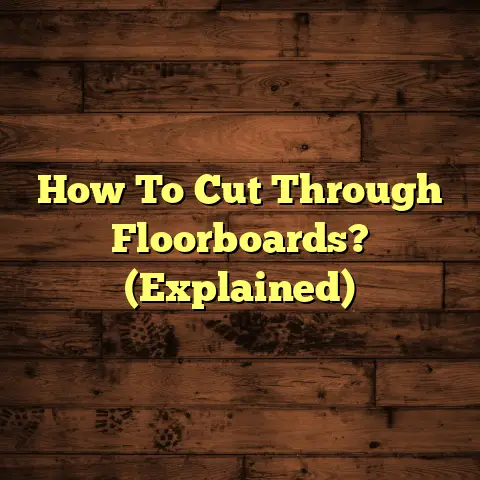Epoxy Flooring Cost Australia (Explained)
Epoxy flooring has gained popularity in recent years due to its durability, aesthetic appeal, and versatility. As a cost estimator with expertise in flooring, this article delves deep into the costs associated with epoxy flooring installation in Australia, addressing key factors that influence price and offering insights for homeowners and businesses alike.
Overview of Major Cost Factors
When estimating the cost of epoxy flooring, several key factors come into play:
1. Area Size
- The larger the area, the higher the overall cost. However, larger projects often benefit from economies of scale, potentially lowering the per-square-metre cost.
2. Epoxy Type
- There are various types of epoxy flooring, including self-leveling, thin-film, and flake epoxy systems. Each type has a different price point based on materials and installation complexity.
3. Labor Costs
- Professional installation is recommended for epoxy flooring due to the technical nature of the application. Labor costs can vary widely depending on location and contractor experience.
4. Surface Preparation
- Preparing the existing floor is crucial for ensuring a successful installation. Costs can increase if extensive preparation is required, including cleaning, grinding, or repairing the substrate.
5. Additional Considerations
- Other factors that may impact costs include:
- Removal of Existing Flooring: If there is old flooring that needs to be removed, this will add to the overall expense.
- Subfloor Replacement: Damaged subfloors may need replacing, increasing costs.
- Material Quality: Higher quality epoxies tend to cost more but offer better durability and aesthetics.
- Design Complexity: Custom designs or intricate patterns can raise installation costs.
Detailed Cost Breakdown
Average Costs
- Basic Epoxy Flooring: AUD 50 – AUD 75 per square metre
- Mid-Range Epoxy Systems: AUD 75 – AUD 120 per square metre
- High-End Systems (Custom Designs): AUD 120 – AUD 200+ per square metre
Cost by Project Size
- Small Projects (20-50 m²): AUD 1,000 – AUD 5,000
- Medium Projects (50-100 m²): AUD 5,000 – AUD 12,000
- Large Projects (100+ m²): AUD 12,000 and up
Comparing Epoxy Flooring with Alternatives
When considering epoxy flooring, it’s essential to weigh it against alternative options:
| Flooring Type | Average Cost (per m²) | Pros | Cons |
|---|---|---|---|
| Epoxy | AUD 50 – AUD 200+ | Durable, easy to clean, aesthetic appeal | Requires professional installation, can be slippery |
| Laminate | AUD 20 – AUD 60 | Affordable, easy to install | Less durable than epoxy, may look less authentic |
| Vinyl | AUD 30 – AUD 80 | Water-resistant, comfortable underfoot | Can dent easily, shorter lifespan |
| Carpet | AUD 25 – AUD 100 | Soft and warm, sound dampening | Stains easily, requires more maintenance |
Signs Your Epoxy Floor Needs Replacement
- Visible Cracks or Chips: Over time, wear and tear can cause structural damage.
- Peeling or Bubbling: This indicates a failure in adhesion or moisture issues.
- Discoloration: Fading or yellowing can be a sign of UV damage or chemical exposure.
- Persistent Odours: Unpleasant smells may indicate underlying moisture problems.
Refinishing vs. Replacement
When your epoxy flooring shows signs of wear, you may wonder whether to refinish or replace it. Here are some considerations:
Refinishing
- Pros: More cost-effective; can restore the original look.
- Cons: Limited to minor surface issues; may not address underlying problems.
Replacement
- Pros: A fresh start; can incorporate upgrades or new designs.
- Cons: Higher upfront costs; longer downtime.
Pros and Cons of Epoxy Flooring
Pros
- Durability: Resistant to scratches, stains, and chemicals.
- Aesthetic Variety: Available in numerous colours and finishes.
- Ease of Maintenance: Simple cleaning process; no need for waxing.
Cons
- Installation Complexity: Requires skilled professionals for proper application.
- Temperature Sensitivity: May not be suitable for extreme heat or cold environments.
- Initial Cost: Higher upfront investment compared to some alternatives.
Professional Installation vs. DIY
When considering installation methods for epoxy flooring, here’s what to keep in mind:
Professional Installation
- Cost: Higher initial costs due to labor fees.
- Skills Required: Professionals have the expertise and tools necessary for a high-quality finish.
- Importance of Proper Installation: Ensures longevity and avoids costly mistakes.
DIY Installation
- Cost Savings: Can save on labor costs.
- Skills Needed: Requires knowledge of epoxy application and surface preparation.
- Risks: Improper installation can lead to peeling, bubbling, or uneven surfaces.
Questions to Ask Epoxy Flooring Contractors
- What types of epoxy do you recommend for my space?
- Can you provide references from previous clients?
- What is included in your quote?
- How long will the installation take?
- Do you offer a warranty on your work?
- What preparations do I need to do before installation?
Care and Maintenance Tips for Epoxy Floors
To maximise the longevity of your epoxy flooring:
- Regular Cleaning: Sweep or vacuum regularly to remove debris.
- Mopping: Use a mild detergent with water for mopping; avoid harsh chemicals.
- Avoid Scratches: Use floor mats at entryways and furniture pads under heavy items.
- Address Issues Promptly: Repair any chips or cracks immediately to prevent further damage.
Conclusion
Epoxy flooring can be a fantastic investment for both residential and commercial spaces due to its durability and aesthetic appeal. By understanding the factors that influence cost and weighing them against other flooring options, you can make an informed decision that best suits your space and budget. Whether you choose professional installation or consider going the DIY route, thorough research and planning will ensure you achieve the best results for your flooring project in Australia.





